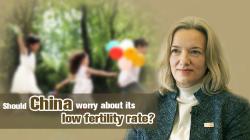Editor’s note: The government’s activity report submitted during the Two Sessions set out the accompanying measures for the third child policy. But the latest census showed that the country’s total fertility rate was at a low of 1.3 in 2020. What are the factors that can influence a family’s decision to have more children? How should people understand low fertility? Dr. Justine Coulson, Representative of the United Nations Population Fund (UNFPA) in China, shares her insights. The opinions expressed in the video are his own, and not necessarily those of CGTN.
“Couples should ask themselves four questions before deciding how many children they intend to have.”
I mean, last year we saw that China had the lowest number of births it’s probably had in the last 60 years. And we are now talking about a total fertility rate of 1.3, which means that on average each woman has 1.3 children.
But demographic changes and what China is seeing are not unique to China. What we are seeing around the world is that as economies grow, you will see a reduction in fertility. The reasons are many.
One of them is that in less developed economies you will see a greater reliance on children for subsistence farming. Families consider having more children almost like an insurance policy. But as the quality of health care improves, as the wealth of individual households improves, as education levels improve, then the need for having these very large families is no longer there.
At the same time, over the last 50 or 60 years, we have seen a huge increase in terms of education levels for women, with women also entering the workforce. It has also had an impact on the number of children couples choose to have.
But if you take it on a personal level, because deciding how many children you have is a personal matter, I always say that I think couples ask themselves four questions.
The first question is: Can we afford it? And a lot depends on how much does it cost to have a living space big enough to have more than one child, how much education costs, how much extracurricular activity costs, and what investments we want to see.
The second question a couple asks is how to reconcile work and children, to have a childlike family life. So if I have to work 12 hours a day, six days a week and my spouse has to work six days a week for 12 hours, how are we going to have a bigger family? And so that obviously impacts the decision.
And I always say that the third question then is maybe a question more than a woman asks herself, whether we’re going to have all these kids, who’s actually going to spend her time looking after the kids and managing the domestic sphere?
If it is the woman alone, then the desire for more children would be very different than if we actually saw a couple taking equal responsibility for childcare and equal responsibility for the domestic sphere.
And that’s actually what research is now showing, which shows very clearly that when men take on more responsibility for household chores and childcare, you’ll see a couple be more willing to consider having a additional child.
The fourth, which I think we think less about in terms of economics and demographics, is: do we really want to have more children? And what I mean by that is that the model of parenthood and what it means to be a good parent has changed significantly over the past 50 years.
Now, parents are thinking a lot more about the quality of the relationship they have with their child and how they go about investing themselves as much as possible in their child and ensuring the best possible future.
With this type of fairly intensive parenting model, it obviously becomes a lot harder to maintain that and be this “modern concept” of a good parent if you have more children. It can also figure into deciding how many children you might have.
“UNFPA would say that demographic transitions have happened throughout history; these are not necessarily bad things.
I mean the United Nations Population Fund (UNFPA) would say that these demographic transitions have happened throughout history; these are not necessarily bad things. It’s about looking at how your demographic change is happening and then thinking about how the government is looking at the best investments you can make to really exploit the population that’s there.
For China, it is now entering a demographic transition of an aging population, as seen in many countries around the world. And now we’re talking about the potential for a second dividend.
So when you see this aging population and this large cohort of older people in the population, where traditionally you thought you were born, you’re a child, you’re working, you’re retiring, you’re ‘we stop working, now I think there’s a whole new way of thinking about old age because people are getting to 60 or 65, they’re healthier, they’re richer, they’re better educated , life expectancy has increased, and we are now talking about living to 100 being a normality in the next 20 to 30 years. No one is going to stop working at 65 and sit around for the next 35 years doing nothing.
So, thinking about the second demographic dividend, what policies, investments and workplace changes do we need to make to truly enable these older people to play this productive role in society?
Interviewer: Huang Jiyuan
Camera: Ma Wei, Liu Tianxu
Video editor: Feng Ran
Editor-in-Chief: Li Yunlong
Producer: Wang Xinyan
Supervisor: Mei Yan
(If you would like to contribute and have specific expertise, please contact us at opinions@cgtn.com. Follow @thouse_opinions Twitter for the latest comments in CGTN’s Opinion section.)

